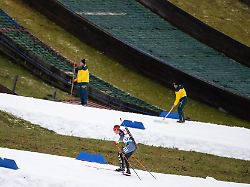Giganticism and city events?
How endangered winter sports are planning for the future
2/8/2023 7:34 p.m
Less and less snow and high temperatures are forcing sports such as ski jumping and biathlon to rethink. A race director dreams of becoming a kind of winter Formula 1. Climate change poses serious challenges to several disciplines.
Narrow, white bands of snow in the middle of a green landscape become an alarm signal for winter sports. What’s next when it’s getting warmer and even making artificial snow is difficult? In view of the increasingly tricky conditions in many winter sports regions, new ideas and fresh concepts are needed for the future. Considerations range from expansion into hardy areas to non-snow alternatives.
Ski jumping as a year-round and global sport that no longer depends on the winter months? Biathlon as a city event on roller skis in metropolises instead of, as before, in beautiful Alpine towns? What seemed unthinkable 20 years ago could become a real option given the serious threat to winter sports. Major changes are also being discussed in the ice track.
“I think you always have to be open to new things”
If race director Sandro Pertile has his way, ski jumping will be the Formula 1 of the winter in the future. “We want to become a global sport, because at the moment we are too European a sport. We want to expand more to the east and west,” said Pertile of the “Heilbronner Voice”. Most ski jumping world cups are currently held in Europe. Only now and then there are world cups in Japan or the USA, other organizers are a rarity.
But the jumpers are rather skeptical about the Italian’s expansion plans. “We definitely don’t complain when we have a lot of competitions. I don’t know if we’re comparable to Formula 1. The road is relatively far, there’s significantly less money in ski jumping,” said ski jumper Constantin Schmid of the Germans press agency. Teammate Karl Geiger sees it similarly: “I think you always have to be open to new things. Formula 1 is a bit of a different business.”
Olympic champion Andreas Wellinger also doubts the plans. “It won’t work on every continent for us,” said the 27-year-old, who is basically open to new competition venues. Wellinger sees designing the future World Cup calendar as a “difficult challenge”. When planning, the question is also crucial: artificial snow or mat?
Winter sports as a summer event?
This season, the Ski Jumping World Cup started earlier to avoid clashing dates with the Football World Cup in Qatar – in the open instead of on the usual white background. An option that also seems viable apart from the expansion plans. “The good thing about ski jumping is that you can do it without snow. We can also jump on mats and I think that’s the alternative if necessary,” said ski jumper Katharina Althaus. She would also have no problem with a season start in the USA or Canada.
Forms of competition without snow also seem to be an alternative in biathlon. “Maybe it’s also the future that it will be a summer event,” said ex-biathlete Erik Lesser in an interview with “Zeit”. “If we compete in the summer and want to appeal to more people, you can also strap laser guns on your back and do biathlon in the cities! World Cup in downtown Oslo, World Cup in downtown Munich. I think there’s a lot of potential there.” Big cities are – apart from the Holmenkollen in Oslo – rather a rarity in winter sports, instead it is often in small towns like Ruhpolding or Hochfilzen.
“Cross-country skiing and snow, winter and biathlon – belong together”
Currently there are only a few show events on roller skis in biathlon in the summer months. But the sporting value of the summer competitions could increase. “For me it belongs together, cross-country skiing and snow, winter and biathlon, but if it’s supposed to be like that, we can do it, the viewer gets used to it, somehow it always works,” said Olympic champion and ex-biathlete Laura Dahlmeier. The impending change is real, the current and former are dealing specifically with the topic.
A future of biathlon as a winter sport in this country hardly seems possible. “In 20 years, winter sports in Central Europe will perhaps be abolished because the conditions are simply such that you can no longer produce enough snow,” said Lesser. The sport will then tend to migrate towards North America or Asia. On the part of the biathlon world association, such expansion plans up to the year 2030 are almost impossible. The two World Cups in the USA and Canada, which have been held every four years, are traditionally poorly attended. Since there is no market for biathlon in North America and especially in Asia, Europe remains the clear priority on the World Cup calendar.
The high travel and transport costs as well as the time difference also speak against the expansion. In bobsleigh, where there are considerations for an Asia and America tour, many nations can hardly afford the enormously increased transport costs. In view of the climatic changes, a later start to the season is an option here. “In October it’s sometimes 20 degrees, so the track just swims away. We’re well served if we freeze a month later and let the season last a month longer,” said luger Dajana Eitberger. Showman Felix Loch also spoke out in favor of a later start to the season.
